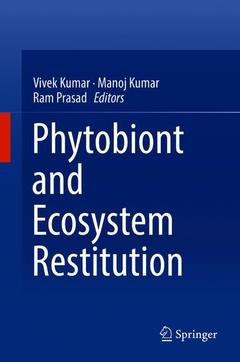Phytobiont and Ecosystem Restitution, 1st ed. 2018
Coordonnateurs : Kumar Vivek, Kumar Manoj, Prasad Ram

This book offers present-day retrospectives and future perspectives on ?phytobiont? studies in the context of phyto-micro restitution, filling some of the information gaps in this promising research field. It discusses several ecosystem restitution strategies using dissimilar groups of microbes alone or in association with plants, as well as advances in metagenomics technology for studying in situ micro and macro communities in contaminated soil. It addresses topics such as the status quo, and the perspectives of microbial researchers and scientists, foresters, students, environmentalists, agriculturists and professional engineers. The rising pollution levels caused by xenobiotics is one of the biggest problems of our times, and as such the book comprehensively elaborates the latest research in this field and describes how the issue can be tackled using micro-organisms.
With detailed diagrams and illustrations, the book is a valuable resource for experts and novices in the field of microbial bioremediation, phyto-bioremediation and environmental microbiology
Dr. Vivek Kumar is an Associate Professor working at the Himalayan School of Biosciences, Swami Rama Himalayan University, Jolly Grant, Dehradun, India. He currently serves on the editorial boards of various respected international journals, including Environment Asia, International Journal of Biological & Chemical Sciences, Environmental Sustainability, Journal of Advanced Botany and Zoology, and Journal of Ecobiotechnology. He is also a reviewer for prestigious international journals such as the Journal of Hazardous Materials, Environmental Sustainability, Science International, Acta Physiologiae Plantarum, Environment Science & Pollution Research, and Rhizosphere. He has authored more than 100 publications, including research papers, review articles, book chapters, and also edited several Springer books. Dr. Kumar has served as a microbiologist at the Department of Soil and Water Research, Public Authority of Agricultural Affairs & Fish Resources, Kuwait for eight years. He has been credited with first reporting and identification of Pink Rot inflorescence disease of date palms in Kuwait caused by Serratia marcescens. He was awarded the 2002 ‘Young Scientist Award’ in Agricultural Microbiology by the Association of Microbiologists of India (AMI). Dr. Kumar's research areas include plant-microbe interactions, environmental microbiology and bioremediation. He has also organized various outreach activities.
Dr. Manoj Kumar is an Associate Professor, Centre for Life Sciences, Central University of Jharkhand, Ranchi, India. He is committed to high-quality science that contributes to both increasing intellectual knowledge of plant development and increasing the ecological niche. Dr. has pursued his PhD in Plant Biotechnology at the prestigious Jawaharlal Nehru University and was then awarded two postdoctoral fellowships: i) DBT-PDF from IISc Bangalore in 2005 and then NRF-PDF from the Universities of Pretoria and Melbourne. He
Date de parution : 01-2019
Ouvrage de 487 p.
15.5x23.5 cm



